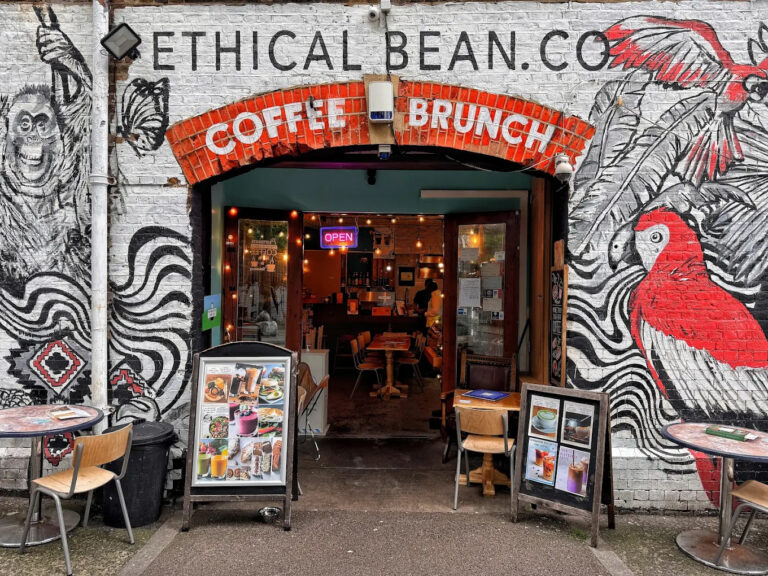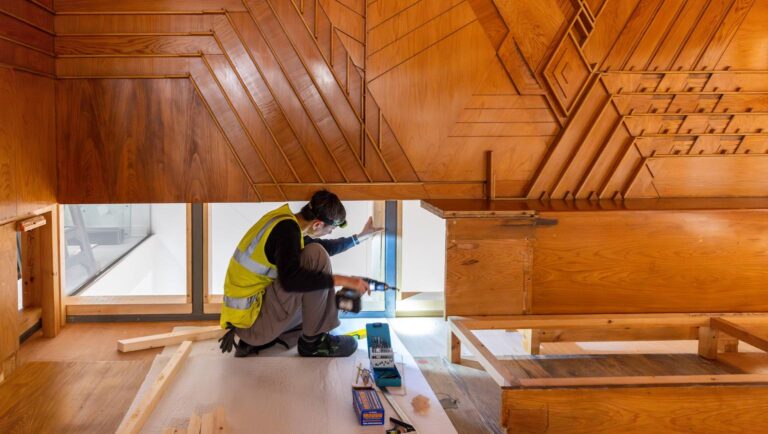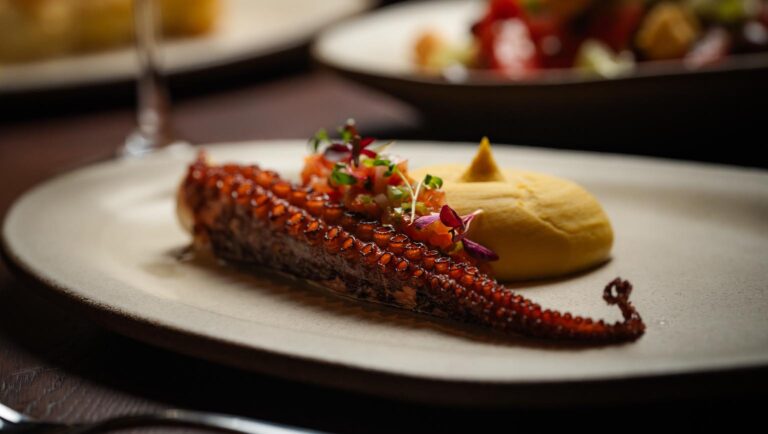
The Best Eating & Drinking on Fish Island
Your timely reminder to go visit these amazing restaurants, bars and cafes this summer while we wait for better bridge access…
It’s a Sunday morning, 8am, and I’m squinting into a dark black abyss in the middle of a Hackney Wick building site. And yet, I am filled with pure joy: this abyss is the ashy guts of a sauna stove. I’m opening the shift at the Hackney Wick Sauna Baths. I’ve got two hours to get the fire going and the sauna heated up to somewhere between 60 and 100 degrees centigrade. Three large whiskey barrels are filling up behind me, offering a full-body cold plunge to cycle between sauna sessions. Fresh out of the winter underground, the thermometer bobbing in them is reading six degrees centigrade. Two environments that push humans to the furthest realms of their discomfort. And yet, we’re fully booked for the day. Week-to-week, we wave goodbye to gooey-eyed beaming faces, then welcome them back again. How can something so punishing be so moreish?
Communal sweat bathing has been both consistent and persistent throughout history, dating back thousands of years and appearing all over the globe. The fact that it developed independently across so many different cultures suggests there is some innate human drive to experience extreme heat, some deep-seated benefit that’s helped us to survive and thrive. Bathing is universal: globally, cultures have created or inherited rituals to connect, clean and feel good. Irish, Turkish, Russian, Estonian, Native American, Finnish, Korean, Lithuanian, German, Japanese, Bantu African, Yiddish, Moroccan. Just a selection of global bathing cultures – and many more have existed throughout history.
So why have humans ended up, time and time again, gathering together to sweat? Perhaps at its simplest: it feels great. When we sauna, the heat and the cold trigger our body’s natural painkilling system, releasing a feelgood rush of beta-endorphins. Many activities that humans seek out – exercise, music, chocolate, meditation, sex and laughter – trigger these feelgood chemicals in the brain, and when there’s enough of them, we experience feelings of euphoria. Understanding this system also helps us to understand some of the benefits reported by regular bathers. Beta-endorphins also help to mediate our response to acute stress and may explain why exercise and sauna can help keep us level-headed through stressful events. Drugs and alcohol are also closely linked to our endorphin system. For those recovering from addiction issues, exercise and sauna can help people bridge to healthier ways to feel good and facilitate the rebalancing of the body’s pain/pleasure response.
But feeling good isn’t enough to explain the whole host of physical and mental health benefits that have been scientifically validated in recent years. A Finnish study of 2,300 men by Dr Jari Laukannen and his team, following their sauna bathing habits and the disease and death that befell them over a number of decades, has found that regular sauna bathing reduces the incidence of Alzheimer’s, heart disease, premature death, and even psychosis. Another body of research by Dr Charles Raison in the USA has found that intense heat exposure can have an immediate antidepressant effect that lasts up to six weeks, and a study is currently underway to explore how it can improve the outcomes of cognitive behavioural therapy (CBT).

Three key reactions are triggered by heat stress in the body producing wide-ranging benefits: increased circulation, heat-shock proteins, and inflammatory responses. When we begin to heat up in the sauna, our bodies respond by dilating our blood vessels, increasing blood flow to the skin so that sweating can happen and heat can be lost from the body. This is accompanied by an increase in heart rate to hasten blood being pumped to the skin. Remarkably, this response mimics that of medium-intensity exercise and offers many of the same benefits, particularly those relating to cardiovascular health. For this reason, sauna can give the benefits of exercise to those with limited mobility, like the elderly or disabled.
Another beneficial response for our bodies is the activation, by both hot and cold, of heat-shock proteins in our cells. These increase the repair of damaged proteins and trigger antioxidant and anti- inflammatory effects on the rest of the body. Damaged proteins are a hallmark of many cardiovascular and neurodegenerative diseases like Alzheimer’s and Parkinson’s, so maintaining the integrity of our protein production holds off the development of these illnesses. Heat-shock proteins can also be triggered by a wide range of stresses on the body, including fasting (nutrient deprivation) and breathwork (hypoxia). Perhaps the most fundamental reaction, however, is how sauna use affects inflammation.
Modern lives are pro-inflammatory on many fronts. Psychosocial stress, obesity, sedentary lifestyles, high-fat high-sugar diets, smoking and pollution, lack of sleep, loneliness and being poor all contribute to putting many individuals into a state of ‘chronic inflammation’. This is where our bodies have been so agitated by mild everyday stressors they become primed into a permanent state of illness-readiness. Being in an inflamed state triggers ‘sickness behaviours’: tiredness, social withdrawal, low mood, oversensitivity to social threats and strangers, and feeling hot all the time. These behaviours are similar to those experienced in depression, leading experts to research the idea that depression might be the result of chronic inflammation. There’s even evidence to suggest that high states of inflammation block our ability to synthesise serotonin in our brains. Curiously, beneficial activities like sauna and exercise actually induce an intense inflammatory response in our bodies. But unlike other gentle yet ongoing stressors which keep inflammation high, they act to recalibrate our inflammation profile for the longer term: the short-term pain results in a long-term gain.

Before disappearing in the 1970s, public baths (modelled after multi-room Roman/Turkish sweat baths) had long been integral to community life and health in Britain. For most of known British history, bathing has been a communal and public activity that became the foundation for some of our most prominent cultural towns, such as Bath, Cheltenham, Buxton and Harrogate. But it was only in Victorian times that the value of heat for bathing became prevalent, inspired by Turkey but following Roman designs. Noted for their ability to cure a number of afflictions like rheumatism, neuralgia and gout, over 600 Turkish Baths popped up across the UK and Ireland in the 19th century.
The location of our current home on Eastway was, in a former life, a more pragmatic version: a place where people could clean themselves in a bath tub and do their laundry for the week. The Eastway Baths were opened in 1935 by the Metropolitan Borough Council of Hackney at a time when almost all of the houses in the area lacked their own bathrooms. Improved understanding of disease highlighted the importance of personal cleanliness for public health and campaigns were run to educate citizens on why they should wash. Advances in plumbing and drainage technology ushered in the decline of the public bath as private bathrooms became commonplace. At the same time, after reigning as a must-have trend in the 1970s, saunas became a smokescreen for clandestine sexual exploits. Where sauna can be found nowadays, they are for the most part either poor quality or at ‘luxury’ prices.
The Community Sauna Baths project was set up to deliver the vision of the British Sauna Society, which aims to promote authentic sauna practices in the UK. Drawing from different international sauna traditions and committing to ensure the highest sauna quality and experience, a revival of British bathing culture is in unstoppable motion. From household celebrities like David Beckham, Liz Hurley, Joe Wicks or Ben Fogle sharing their adoration for sauna on Instagram, to the wildly popular mobile saunas that pop up on a new beachfront every month, the UK is now catching up. Bringing community sauna to Hackney Wick was the idea of project founder Victoria Maddox, who spent lockdown as a boater. After her venture that took a mobile 12-person sauna into nature was stalled by the pandemic, Victoria looked at the possibility of bringing the concept closer to home: “Being so immersed with London boaters, I saw community that could directly benefit from a bathhouse to socialise and wash in.”

Victoria put the idea into action after seeing City Hall’s Make London fund offering grants to projects to help communities recover in the wake of the pandemic. A campaign and crowdfunder was put together, and a team assembled. Despite amassing pledges amounting to nearly £30k, six months of campaigning ended up with £0 in funding. The big realisation was that networks of support and passionate individuals were much more important to making the project happen than any kind of funding. Neil McDonald of Stour Space has supported us all the way, eventually providing a home at his new venture in the Baths on Eastway, which meant starting with no funding was possible. Every penny made is now reinvested back into making the sauna baths even better.
This Great British bathing revival comes at a turning point for many former bathhouses that, like many places we know and love, are being marched towards demolition or ‘redevelopment’. For many modern developments, coming together with friends and family is based on a heavy commercial element: boozing at a chic cocktail bar, or stuffing your face at a chain restaurant. Often, these tower over the shells of former community cornerstones: local boozers, working men’s clubs, church halls, public baths.
The last fifty years have slowly shut off spaces where people could come together and forge their individual identities into a larger communal whole. Much of wellness culture is focused on the individual: reaching your goals, and becoming the best version of you possible. Reviving public baths is an opportunity to resurrect vital community assets in an age where our need for collectivism has been starved for commercial advantage. Approaching health individually has neglected the socially interconnected nature of our wellbeing. Linking isolated individuals into a support network has been shown to dramatically lower emergency care admissions.
Acknowledging this has led to the concept of ‘social prescribing’, where link workers take time to understand people, educate about wellbeing and health and connect them with community activities. Led by doctor and Community Sauna Baths director Oguguo Igwe, we’re working to get heat therapy included in these sorts of health approaches and are in talks with universities to start quantifying the beneficial impact that community sauna can have for people. Mika Meskanen, Finnish native and co-founder and chair of the British Sauna Society, also sees sauna as a place that fosters creativity and innovation. “Saunas are naturally communal – sharing good heat and steam followed by a cold plunge and chilling out in the fresh air brings people peacefully together. What if public saunas could become eclectic meeting points and conversational hubs? Like the 17th century coffee houses – Penny Universities – that helped spark the Enlightenment?”
Find out more and book a visit
Aho Sweat Lodge
Another traditional benificial heat experience is a sweat lodge, and Hackney Wick-based organisation Aho Community offers monthly visits to a Temescal, which is a low profile dome-shaped hut made with natural materials. The sweat is intended as a spiritual and purification ceremony, for prayer and healing. It takes place in a beautiful field in Hainalt, just a few stops east from the city. More info at: aho.community

Your timely reminder to go visit these amazing restaurants, bars and cafes this summer while we wait for better bridge access…

The twist and turns of post-Olympics decision-making that brought 250,000 objects to Here East

This thoroughly modern restaurant may be far from the taverna, but it’s filled with Mediterranean flavours, and much more
A joint venture in collaborative local media from:


In partnership with

Regulated by IMRESSS, the Independent Monitor for the Press CIC.
For more info on our complaints policy, or to make a complaint, visit FAQ.
